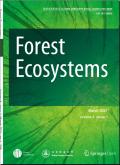群落完整性的驱动因素和模式表明,托斯卡纳法桐森林的植物多样性可能很低
IF 4.4
1区 农林科学
Q1 FORESTRY
引用次数: 0
摘要
欧洲山毛榉(Fagus sylvatica L.)林的植物物种丰富度和丰度变化很大,既有单一物种的林分,也有物种高度丰富的群落。为了了解某些山毛榉林中植物多样性较低的原因,我们分析了 155 个植被地块中植物群落完整性的驱动因素。数据采集于意大利中部托斯卡纳的成熟闭冠山毛榉林。根据物种共存情况估算了特定地点的物种库。我们使用广义最小二乘法线性建模来评估人为和环境因素对整个群落完整性和山毛榉林专有物种集的影响。我们还测试了草本植物层总覆盖率对所选预测因子的响应,并通过非度量多维尺度排序法将预测变量和响应变量与物种组成联系起来。整个群落和榉树林专类群落的完整性受榉树总覆盖度的负面影响,而受坡度的正面影响。此外,整个群落的完整性受海拔的负面影响,而受干扰频率的正面影响。草本层的覆盖率随着山毛榉覆盖率、海拔和降水量的增加而降低。高群落完整性和高草本层覆盖率与低海拔山毛榉林中落叶混交林嗜热物种的存在有关。我们的研究结果表明,植物群落完整性低和草本层覆盖率低的主要原因是山毛榉在其最佳生态环境中形成纯林时自身的竞争。在海拔较高和坡度较低的地方,这种竞争会更加激烈,因为在这些地方,榉树枯落物的积累对林下物种来说是一个限制因素。这些证据表明,成熟山毛榉林中物种的缺失主要是自然因素造成的,因此不应被视为森林生态退化的指标。本文章由计算机程序翻译,如有差异,请以英文原文为准。
Drivers and patterns of community completeness suggest that Tuscan Fagus sylvatica forests can naturally have a low plant diversity
European beech (Fagus sylvatica L.) forests can have a high variability in plant species richness and abundance, from monospecific stands to highly species-rich communities. To understand what causes the low plant diversity observed in some beech forests, we analyzed the drivers of plant community completeness in 155 vegetation plots. Data were collected in mature, closed-canopy beech forests in Tuscany, central Italy. Site-specific species pools were estimated based on species co-occurrences. We used Generalized Least Squares linear modeling to assess the effects of anthropogenic and environmental drivers on the community completeness of whole communities and on the set of specialist species of beech forests. We also tested the response of the total cover of the herb layer to the selected predictors and related both the predictive and response variables to species composition in a Non-metric Multidimensional Scaling ordination. The community completeness of whole communities and that of beech forest specialists were negatively affected by total beech cover and positively influenced by slope. Moreover, the community completeness of whole communities was negatively impacted by elevation and positively influenced by disturbance frequency. The cover of the herb layer decreased with increasing beech cover, elevation, and precipitation. High community completeness and high cover of the herb layer were associated with the presence of thermophilic species of mixed deciduous woods in low-elevation beech forests. Our results suggest that a low plant community completeness and a low cover of the herb layer are mainly due to the competition by beech itself when it forms pure forests in its ecological optimum. Such competition is better exerted at upper elevations and in sites with low slopes, where beech litter accumulation is a limiting factor for understory species. Such evidence suggests that species absence in mature beech forests is mainly due to natural drivers and should therefore not be considered an indicator of ecological degradation of the forest.
求助全文
通过发布文献求助,成功后即可免费获取论文全文。
去求助
来源期刊

Forest Ecosystems
Environmental Science-Nature and Landscape Conservation
CiteScore
7.10
自引率
4.90%
发文量
1115
审稿时长
22 days
期刊介绍:
Forest Ecosystems is an open access, peer-reviewed journal publishing scientific communications from any discipline that can provide interesting contributions about the structure and dynamics of "natural" and "domesticated" forest ecosystems, and their services to people. The journal welcomes innovative science as well as application oriented work that will enhance understanding of woody plant communities. Very specific studies are welcome if they are part of a thematic series that provides some holistic perspective that is of general interest.
 求助内容:
求助内容: 应助结果提醒方式:
应助结果提醒方式:


